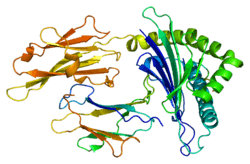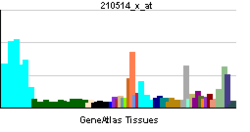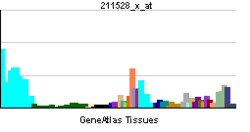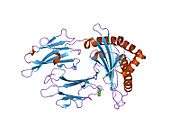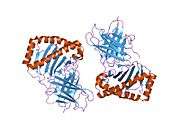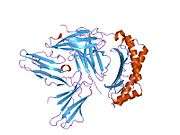HLA-G
| View/Edit Human | View/Edit Mouse |
HLA-G histocompatibility antigen, class I, G, also known as human leukocyte antigen G (HLA-G), is a protein that in humans is encoded by the HLA-G gene.[3]
HLA-G belongs to the HLA nonclassical class I heavy chain paralogues. This class I molecule is a heterodimer consisting of a heavy chain and a light chain (beta-2 microglobulin). The heavy chain is anchored in the membrane. HLA-G is expressed on fetal derived placental cells. The heavy chain is approximately 45 kDa and its gene contains 8 exons. Exon one encodes the leader peptide, exons 2 and 3 encode the alpha1 and alpha2 domain, which both bind the peptide, exon 4 encodes the alpha3 domain, exon 5 encodes the transmembrane region, and exon 6 encodes the cytoplasmic tail.[3]
Function
HLA-G may play a role in immune tolerance in pregnancy, being expressed in the placenta, while the classical MHC class I genes HLA-A and HLA-B are not.[4] HLA-A and -B downregulation results in protection from cytotoxic T cell responses, but would in theory result in a missing self response by natural killer cells. HLA-G is a ligand for NK cell inhibitory receptor KIR2DL4, and therefore expression of this HLA by the trophoblast defends it against NK cell-mediated death.[5]
However, a big family with several members bearing only "null" HLA-G alleles has been found. None of these homozygous subjects have pregnancy or birth difficulties; nor do they present immunodeficiencies, autoimmune diseases, or tumors.[6][7] It is striking that this "null" allele (HLA-G*01:05N), while it is quite frequent in some populations, like in Iranians, it is almost absent in some Amerindian populations.[8] Also, some higher primates do not show all MHC-G isoforms.[9] In addition, Cercopithecinae middle-sized Old World monkeys do not bear full MHC-G molecules since all of these monkeys present stop codons at MHC-G DNA.[10] All of these anomalies must be studied.
The presence of soluble HLA-G (sHLA-G) in embryos is associated with better pregnancy rates. In order to optimize pregnancy rates, there is significant evidence that a morphological scoring system is the best strategy for the selection of embryos.[11] However, presence of soluble HLA-G might be considered as a second parameter if a choice has to be made between embryos of morphologically equal quality.[11]
Interactions
HLA-G has been shown to interact with CD8A.[12][13]
References
- ↑ "Human PubMed Reference:".
- ↑ "Mouse PubMed Reference:".
- 1 2 "Entrez Gene: HLA-G HLA-G histocompatibility antigen, class I, G".
- ↑ Jay Iams; Creasy, Robert K.; Resnik, Robert; Robert Reznik (2004). Maternal-fetal medicine. Philadelphia: W.B. Saunders Co. pp. 31–32. ISBN 0-7216-0004-2.
- ↑ Lash, G, Robson, S, Bulmer, J. (2010). "Review: Functional role of uterine natural killer (uNK) cells in human early pregnancy decidua". Placenta. 31 (S): 87–92. doi:10.1016/j.placenta.2009.12.022. PMID 20061017.
- ↑ Suárez MB, Morales P, Castro MJ, Fernández V, Varela P, Alvarez M, Martínez-Laso J, Arnaiz-Villena A (1997). "A new HLA-G allele (HLA-G*0105N) and its distribution in the Spanish population". Immunogenetics. 45 (6): 464–5. doi:10.1007/s002510050235. PMID 9089111.
- ↑ Casro MJ, Morales P, Rojo-Amigo R, Martinez-Laso J, Allende L, Varela P, Garcia-Berciano M, Guillen-Perales J, Arnaiz-Villena A (September 2000). "Homozygous HLA-G*0105N healthy individuals indicate that membrane-anchored HLA-G1 molecule is not necessary for survival". Tissue Antigens. 56 (3): 232–9. doi:10.1034/j.1399-0039.2000.560305.x. PMID 11034559.
- ↑ Arnaiz-Villena A, Enriquez-de-Salamanca M, Areces C, Alonso-Rubio J, Abd-El-Fatah-Khalil S, Fernandez-Honrado M, Rey D (April 2013). "HLA-G(∗)01:05N null allele in Mayans (Guatemala) and Uros (Titikaka Lake, Peru): Evolution and population genetics". Hum. Immunol. 74 (4): 478–82. doi:10.1016/j.humimm.2012.12.013. PMID 23261410.
- ↑ Castro MJ, Morales P, Martinez-Laso J, Allende L, Rojo-Amigo R, Gonzalez-Hevilla M, Varela P, Moscoso J, Garcia-Berciano M, Arnaiz-Villena A (November 2000). "Lack of MHC-G4 and soluble (G5, G6) isoforms in the higher primates, Pongidae". Hum. Immunol. 61 (11): 1164–8. doi:10.1016/s0198-8859(00)00189-0. PMID 11137222.
- ↑ Castro MJ, Morales P, Fernández-Soria V, Suarez B, Recio MJ, Alvarez M, Martín-Villa M, Arnaiz-Villena A (1996). "Allelic diversity at the primate Mhc-G locus: exon 3 bears stop codons in all Cercopithecinae sequences". Immunogenetics. 43 (6): 327–36. doi:10.1007/bf02199801. PMID 8606053.
- 1 2 Rebmann V, Switala M, Eue I, Grosse-Wilde H (May 2010). "Soluble HLA-G is an independent factor for the prediction of pregnancy outcome after ART: a German multi-centre study". Hum Reprod. 25 (7): 1691–8. doi:10.1093/humrep/deq120. PMID 20488801.
- ↑ Gao GF, Willcox BE, Wyer JR, Boulter JM, O'Callaghan CA, Maenaka K, Stuart DI, Jones EY, Van Der Merwe PA, Bell JI, Jakobsen BK (May 2000). "Classical and nonclassical class I major histocompatibility complex molecules exhibit subtle conformational differences that affect binding to CD8alphaalpha". J. Biol. Chem. 275 (20): 15232–8. doi:10.1074/jbc.275.20.15232. PMID 10809759.
- ↑ Sanders SK, Giblin PA, Kavathas P (September 1991). "Cell-cell adhesion mediated by CD8 and human histocompatibility leukocyte antigen G, a nonclassical major histocompatibility complex class 1 molecule on cytotrophoblasts". J. Exp. Med. 174 (3): 737–40. doi:10.1084/jem.174.3.737. PMC 2118947
 . PMID 1908512.
. PMID 1908512.
Further reading
- Carosella ED, Favier B, Rouas-Freiss N, Moreau P, LeMaoult J (2008). "Beyond the increasing complexity of the immunomodulatory HLA-G molecule". Blood. 111 (10): 4862–70. doi:10.1182/blood-2007-12-127662. PMID 18334671.
- Carosella ED, Moreau P, LeMaoult J, Rouas-Freiss N (2008). "HLA-G: From biology to clinical benefits". Trends in Immunology. 29 (3): 125–32. doi:10.1016/j.it.2007.11.005. PMID 18249584.
- Arnaiz-Villena A, Martinez-Laso J, Alvarez M, et al. (1997). "Primate Mhc-E and -G alleles". Immunogenetics. 46 (4): 251–66. doi:10.1007/s002510050271. PMID 9218527.
- Le Bouteiller P (2000). "HLA-G in the human placenta: expression and potential functions". Biochem. Soc. Trans. 28 (2): 208–12. PMID 10816129.
- Geyer M, Fackler OT, Peterlin BM (2001). "Structure–function relationships in HIV-1 Nef". EMBO Rep. 2 (7): 580–5. doi:10.1093/embo-reports/kve141. PMC 1083955
 . PMID 11463741.
. PMID 11463741. - Langat DK, Hunt JS (2003). "Do nonhuman primates comprise appropriate experimental models for studying the function of human leukocyte antigen-G?". Biol. Reprod. 67 (5): 1367–74. doi:10.1095/biolreprod.102.005587. PMID 12390864.
- Moreau P, Dausset J, Carosella ED, Rouas-Freiss N (2003). "Viewpoint on the functionality of the human leukocyte antigen-G null allele at the fetal-maternal interface". Biol. Reprod. 67 (5): 1375–8. doi:10.1095/biolreprod.102.005439. PMID 12390865.
- Moreau P, Rousseau P, Rouas-Freiss N, et al. (2002). "HLA-G protein processing and transport to the cell surface". Cell. Mol. Life Sci. 59 (9): 1460–6. doi:10.1007/s00018-002-8521-8. PMID 12440768.
- Greenway AL, Holloway G, McPhee DA, et al. (2004). "HIV-1 Nef control of cell signalling molecules: multiple strategies to promote virus replication". J. Biosci. 28 (3): 323–35. doi:10.1007/BF02970151. PMID 12734410.
- Bénichou S, Benmerah A (2003). "[The HIV nef and the Kaposi-sarcoma-associated virus K3/K5 proteins: "parasites"of the endocytosis pathway]". Med Sci (Paris). 19 (1): 100–6. doi:10.1051/medsci/2003191100. PMID 12836198.
- Le Bouteiller P, Legrand-Abravanel F, Solier C (2004). "Soluble HLA-G1 at the materno-foetal interface--a review". Placenta. 24 Suppl A: S10–5. doi:10.1053/plac.2002.0931. PMID 12842408.
- Sköld M, Behar SM (2003). "Role of CD1d-Restricted NKT Cells in Microbial Immunity". Infect. Immun. 71 (10): 5447–55. doi:10.1128/IAI.71.10.5447-5455.2003. PMC 201095
 . PMID 14500461.
. PMID 14500461. - Wiendl H, Mitsdoerffer M, Weller M (2004). "Express and protect yourself: the potential role of HLA-G on muscle cells and in inflammatory myopathies". Hum. Immunol. 64 (11): 1050–6. doi:10.1016/j.humimm.2003.07.001. PMID 14602235.
- Urosevic M, Dummer R (2004). "HLA-G in skin cancer: a wolf in sheep's clothing?". Hum. Immunol. 64 (11): 1073–80. doi:10.1016/j.humimm.2003.08.351. PMID 14602238.
- Carosella ED, Moreau P, Le Maoult J, et al. (2004). "HLA-G molecules: from maternal-fetal tolerance to tissue acceptance". Adv. Immunol. Advances in Immunology. 81: 199–252. doi:10.1016/S0065-2776(03)81006-4. ISBN 978-0-12-022481-4. PMID 14711057.
- Leavitt SA, SchOn A, Klein JC, et al. (2004). "Interactions of HIV-1 proteins gp120 and Nef with cellular partners define a novel allosteric paradigm". Curr. Protein Pept. Sci. 5 (1): 1–8. doi:10.2174/1389203043486955. PMID 14965316.
- Le Maoult J, Rouas-Freiss N, Le Discorde M, et al. (2004). "[HLA-G in organ transplantation]". Pathol. Biol. 52 (2): 97–103. doi:10.1016/j.patbio.2003.04.006. PMID 15001239.
- Tolstrup M, Ostergaard L, Laursen AL, et al. (2004). "HIV/SIV escape from immune surveillance: focus on Nef". Curr. HIV Res. 2 (2): 141–51. doi:10.2174/1570162043484924. PMID 15078178.
- Joseph AM, Kumar M, Mitra D (2005). "Nef: "necessary and enforcing factor" in HIV infection". Curr. HIV Res. 3 (1): 87–94. doi:10.2174/1570162052773013. PMID 15638726.
- McIntire RH, Hunt JS (2005). "Antigen presenting cells and HLA-G--a review". Placenta. 26 Suppl A: S104–9. doi:10.1016/j.placenta.2005.01.006. PMID 15837058.
- Anderson JL, Hope TJ (2005). "HIV accessory proteins and surviving the host cell". Current HIV/AIDS reports. 1 (1): 47–53. doi:10.1007/s11904-004-0007-x. PMID 16091223.
